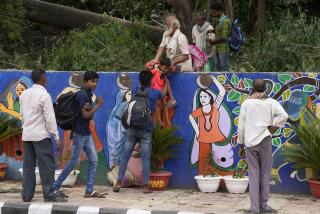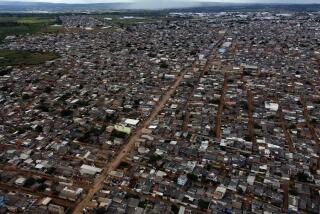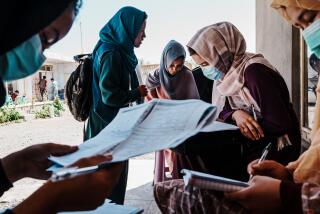Slum School Offers Hope for Calcutta’s Poor
- Share via
CALCUTTA — Ali Hussain goes to school by candlelight. He works all day punching holes in tin for toy harmonicas, and daylight has faded before he gets to his books. Electricity is in short supply.
So are schools. Until six years ago Tikea Para, one of the poorest areas in a city notorious for its slums, had no elementary school.
The predominantly Muslim residents took matters into their own hands, chipping in manpower and a few rupees. Today, 400 children go to a one-room school built, run and taught by people from the neighborhood.
Another 80 child laborers go to night class, not always winning the struggle to stay awake. Ali, 8, says he earns $1.84 a week.
“This is a very backward area. These are poor people, and there are too many child workers,” said Sekander Khan, secretary of the residents’ committee.
“We can’t stop child labor,” Khan said. “If we can’t give them an education, they will be like this all their lives.”
The residents of Tikea Para have gone further than most to collectively help themselves in a city incapable of coping with its population explosion.
In the last 50 years, waves of migrants from Bangladesh and from Indian villages have swollen Calcutta’s population to 12 million. An estimated 43% live in slums, or bustees . Uncounted thousands camp on the street.
Tikea Para is a bustee of about 100,000 people in Howrah, a municipality across the Hooghly River from Calcutta’s business district.
The slum dwellers were galvanized into community action when a woman in the neighborhood was raped by a gang of hoodlums running an illegal liquor store, Khan said. With police help, the residents cleaned out the area, fenced off their bustee and took a hard look at their children’s futures.
The school began in 1984 with 20 children sitting on the dirt in the neighborhood courtyard. They applied for municipal help but were told that other education projects had higher priority, Khan said.
Now children in tidy uniforms attend classes taught by young, unemployed university graduates from the neighborhood. They sit on wooden benches, jostling papers on their laps because they have no desks.
The school operates two daytime shifts, with two grades sitting in the same room each shift. A row of sewing machines occupies the back.
The courtyard has been taken over by a homemade merry-go-round with wooden horses.
Twice weekly a volunteer doctor from a nearby German-sponsored clinic visits the bustee, receiving patients in a tiny back room of the school.
Tikea Para has about 70 small factories worked mostly by children as young as 5. The most recent estimates say India had 16.6 million child laborers in 1986.
The bustees of Calcutta and Howrah mark the decline of a once-great city. Some call them the lowest form of urban life.
Until 1912, Calcutta was the capital of India, the “Second City” of the British Empire after London. Its gracious Gothic buildings, green lawns, wide boulevards and exclusive clubs provided the backdrop for a lifestyle that symbolized the peak of the colonial age.
The Victorian-style buildings are eroding under an assault of grime and neglect. Shantytowns have sprung up in the open spaces of well-to-do areas.
Howrah is a warren of cell-like shacks separated by open sewers. But inside the shacks, the stone floors are spotlessly clean. Residents bathe openly--partially dressed--under water pumps, a ritual that children usually turn into a game.
Hunger is rampant. Rag-draped people can be seen picking through mounds of garbage for scraps of food, competing with mangy dogs, crows and cattle.
It was here that Mother Teresa, a frail Roman Catholic nun, became known as “the saint of the gutters” for giving dying homeless people a bed, care and dignity in their last hours.
But the 800,000 people of Howrah show a surprising resilience and acceptance in the face of crushing poverty and hunger.
“People are not unhappy here, especially the children,” said Helgo Meyer-Hamme, a German doctor on a six-week volunteer stint in the clinic.
“In Germany people are rich, live in nice houses and have plenty to eat, but they are not happy,” Meyer-Hamme said. “Here the children laugh all the time. They can play with anything. Even a little piece of paper can be a toy. We can learn from these people.”
More to Read
Sign up for Essential California
The most important California stories and recommendations in your inbox every morning.
You may occasionally receive promotional content from the Los Angeles Times.













